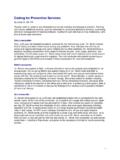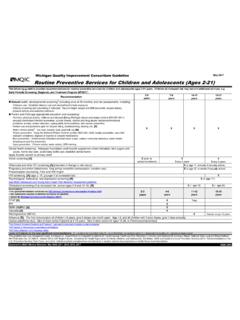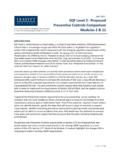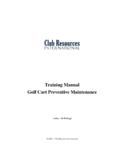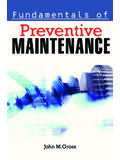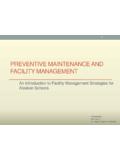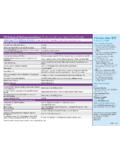Transcription of Preventive Maintenance Principles - MIT OpenCourseWare
1 Preventive Maintenance Principles SPL Scott Couzens, LFM 06 Scott Hiroshige, LFM 06 Presentation for: Summer 2004 iErik Smith, LFM 03 Intel Corporation Lean/Six Sigma Systems MIT Leaders for Manufacturing Program (LFM) These materials were developed as part of MIT's course on "Lean/Six Sigma Systems." In some cases, the materials were produced by the lead instructor, Joel Cutcher-Gershenfeld, and in some cases by student teams working with LFM alumni/ae. Where the materials were developed by student teams, additional nputs from the faculty and from the technical instructor, Chris Musso, are reflected in some of the text or in an appendix 6/2 [/Special Thanks to: DNS Employees: Roger Nuffer David Villareal Marcus Hunsaker Intel Employees: Jonathan Matthews David Latham Eli Sorenson Danny Miller 9/04 --LFM Students] Lean Six Sigma Systems, LFM, MIT Part I: Introduction Part II: Concepts Part III: Application Part IV: Disconnects Part V.
2 Conclusion 6/3 [/Overview Learning Objectives types of Maintenance activities Appreciation of the benefits of Preventive Maintenance Understanding of lean principreventive Maintenance schedule Awareness of specific challenges to implementing Preventive Maintenance Session Design (20-30 min.) Part I: Introduction and Learning Objectives (1-2 min.) Part II: Key Concept or Principle Defined and Explained (3-5 min.) Part III: Exercise or Activity Based on Field Data that Illustrates the Concept or Principle (7-10 min.) Part IV: Common Disconnects, Relevant Measures of Success, and Potential Action Assignment(s) to Apply Lessons Learned (7-10 min.) Part V: Evaluation and Concluding Comments (2-3 min.)]
3 9/04 --LFM Students] Lean Six Sigma Systems, LFM, MIT Familiarity with the different ples for designing a Part I: Introduction Part II: Concepts Part III: Application Part IV: Disconnects Part V: Conclusion 6/4 [/Types of Maintenance Breakdown Maintenance : Waiting until equipment fails before repairing or servicing it Preventive Maintenance (PM): cleaning, or replacing parts to prevent sudden failure (Predictive) On-line monitoring of equipment in order to use important/expensive parts to the limit of their serviceable life Corrective or Predictive Maintenance : Improving equipment and its components so that Preventive Maintenance can be carried out reliably 9/04 --LFM Students] Lean Six Sigma Systems, LFM, MIT Part I: Introduction Part II: Concepts Part III: Application Part IV: Disconnects Part V: Conclusion (Time-based or run-based) Periodically inspecting, servicing, 6/5 [/Benefits of Preventive Maintenance .
4 The cost of breakdown Maintenance is usually much greater than Preventive Maintenance . 1 Preventive Keeps equipment in good condition to prevent large problems Extends the useful life of equipment Finds small problems before they become big ones Is an excellent training tool for technicians Helps eliminate rework/scrap and reduces process variability Keeps equipment safer Parts stocking levels can be optimized Greatly reduces unplanned downtime 1 /l9/04 --LFM Students] Lean Six Sigma Systems, LFM, MIT Part I: Introduction Part II: Concepts Part III: Application Part IV: Disconnects Part V: Conclusion divisions/bp/app/russel cd/PROTECT/CHAPTERS/CHAP15 6/6 [/The Manufacturing Game Similar to the Beer Game Simulates a typical plant with three roles: Operations Manager Maintenance Manager Spare Parts Stores Manager Each round, participants make decisions such as: Which equipment to take down for PMs How to allocate Maintenance resources How many spare parts to order Revenue, cost, output, uptime, inventory are recorded i9/04 --LFM Students] Lean Six Sigma Systems, LFM, MIT Part I: Introduction Part II: Concepts Part III: Application Part IV: Disconnects Part V: Conclusion Source: Business Dynam cs.
5 Systems Thinking and Modeling for a Complex World, Sterman, John D., 2000. 6/7 [/The Manufacturing Game Results Teams who follow a cost-minimization strategy (reactive Maintenance policies) are able to keep costs low for a uptime falling and costs rising. Teams who follow a Preventive Maintenance strategy initially find higher costs and reduced uptime as equipment is taken offline for planned Maintenance . Soon, however, these teams begin to greatly outperform teams following a cost-minimization strategy. i9/04 --LFM Students] Lean Six Sigma Systems, LFM, MIT Part I: Introduction Part II: Concepts Part III: Application Part IV: Disconnects Part V: Conclusion while.
6 However, as defects build up they find their Source: Business Dynam cs: Systems Thinking and Modeling for a Complex World, Sterman, John D., 2000. 6/8 [/When Does PM Make Sense? PM makes sense when the cost of doing PM is less than the cost of NOT doing PM. CDoingPM = and man-hours consumed in PM, potential for making things worse, etc.) CNotDoingPM = makes no difference in preventing the failure), materials and man-hours spent repairing equipment, loss of etc.) PM makes sense if C< C9/04 --LFM Students] Lean Six Sigma Systems, LFM, MIT Part I: Introduction Part II: Concepts Part III: Application Part IV: Disconnects Part V: Conclusion f(hours of not running equipment, loss in employee morale from doing PM instead of real work , materials f(cost of losing/reworking a failed batch (unless PM equipment lifetime, loss in employee morale from NOT doing PM, reduced employee familiarity with equipment, DoingPM NotDoingPM 6/9 [/Optimizing a PM Schedule Question: If a certain piece of production equipment requires ~10 hours of Preventive Maintenance per week, how should those 10 hours be scheduled?]
7 Answer: In a 24x7 manufacturing operation, it is typically better to perform the ~10 hours of activities in several smaller periods of time, for instance 5 PM activities that take ~2 hours each Duration and variability in Preventive Maintenance are key factors in whether equipment will be able to maintain a steady flow of output 9/04 --LFM Students] Lean Six Sigma Systems, LFM, MIT Part I: Introduction Part II: Concepts Part III: Application Part IV: Disconnects Part V: Conclusion 6/10 [/PM Durations: Simulation 1 hours (85% availability) 0 50 100 150 200 250 300 350 400 450 () Drop Page Fields Here io 9/04 --LFM Students] Lean Six Sigma Systems, LFM, MIT Part I: Introduction Part II: Concepts Part III: Application Part IV: Disconnects Part V: Conclusion Simulation of equipment with a 10 hour average PM duration, std dev 20 Trend of Queues for the Toolset 83 88 99 1091141191251331391471521571621671721771 8218719219820321121622122623123624124626 7 Days into Sim ulation Average QueueLength # of Lots1 - 10h mean, 2 CV Avg Queuelength Day ScenarData from a simulation run at Intel Fab 11X.
8 6/11 [/PM Durations: Simulation 2 hours (85% availability) 0 50 100 150 200 250 300 350 400 450 83 88 93 () Drop Page Fields Here io 9/04 --LFM Students] Lean Six Sigma Systems, LFM, MIT Part I: Introduction Part II: Concepts Part III: Application Part IV: Disconnects Part V: Conclusion Simulation of equipment with a 5 hour average PM duration, std dev 10 Trend of Queues for a Toolset 98 103 108 113 118 125 137 155 164 194 201 213 228 233 244 259 264 277 285 Days into Sim ulation Average QueueLength # of Lots2 - 5h mean, 2 CV Avg Queuelength Day ScenarData from a simulation run at Intel Fab 11X. 6/12 [/PM Durations: Simulation 3 hours (85% availability) 0 50 100 150 200 250 300 350 400 450 84 91 102 125 148 160 173 196 209 225 238 273 279 287 () Drop Page Fields Here io 9/04 --LFM Students] Lean Six Sigma Systems, LFM, MIT Part I: Introduction Part II: Concepts Part III: Application Part IV: Disconnects Part V: Conclusion Simulation of equipment with a 2 hour average PM duration, std dev 4 Trend of Queues for a Toolset 116 138 230 261 Days into Sim ulation Average QueueLength # of Lots3 - 2h mean, 2 CV Avg Queuelength Day ScenarData from a simulation run at Intel Fab 11X.
9 6/13 [/PM Durations: Simulation 4 hours (85% availability) 0 50 84 l9/04 --LFM Students] Lean Six Sigma Systems, LFM, MIT Part I: Introduction Part II: Concepts Part III: Application Part IV: Disconnects Part V: Conclusion Simulation of equipment with a 2 hour average PM duration, std dev 6 Trend of Queues for a Toolset 100 150 200 250 300 350 400 450 98 112 117 122 127 133 138 143 148 153 158 163 168 173 178 183 188 193 204 222 242 258 264 275 286 291 Days into Simulation Average QueueLength (# of Lots) 4 - 2h mean, 3 CV Drop Page Fie ds Here Avg Queuelength Day Scenario Data from a simulation run at Intel Fab 11X. 6/14 [/PM Durations: Why they matter For the exact same availability on a piece of equipment: Shorter PM durations mean a difference in days of lotcycle time!]
10 Regardless of the mean, performing PMs inconsistentlyis functionally equivalent to consistently having muchlonger downtime durations 57564) =2h, =6h 883) =2h, =4h 52382) =5h, =10h 63561) =10h, =20h StdDev QueueLengthAvg QueueLengthSimulation 9/04 --LFM Students] Lean Six Sigma Systems, LFM, MIT Part I: Introduction Part II: Concepts Part III: Application Part IV: Disconnects Part V: Conclusion Each day of factory cycle time = millions of $$ Data from simulations run at Intel Fab 11X. 6/15 [/The Waddington Effect First observed by Waddington during WWII forBritish aircraft Maintenance Background theory: unscheduled downtime shouldbe a random phenomenon If all unscheduled downtime events are plotted withrespect to the last PM, there should not be anypattern evident A pattern of increased unscheduled downtimeimmediately following PM s is a WaddingtonEffect 9/04 --LFM Students] Lean Six Sigma Systems, LFM, MIT Part I: Introduction Part II: Concepts Part III: Application Part IV: Disconnects Part V: Conclusion Information from a presentation given at Intel Fab 11X.










